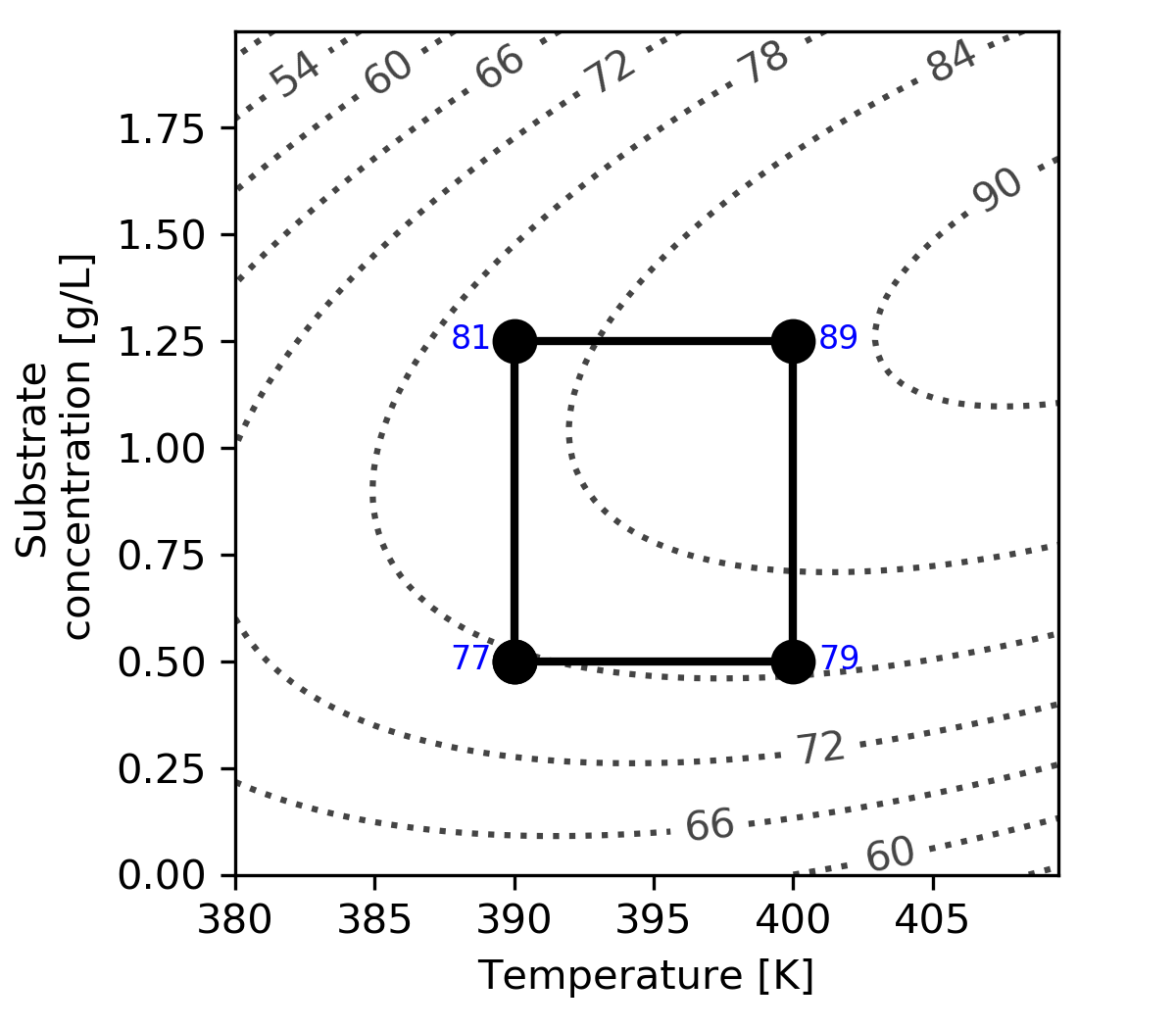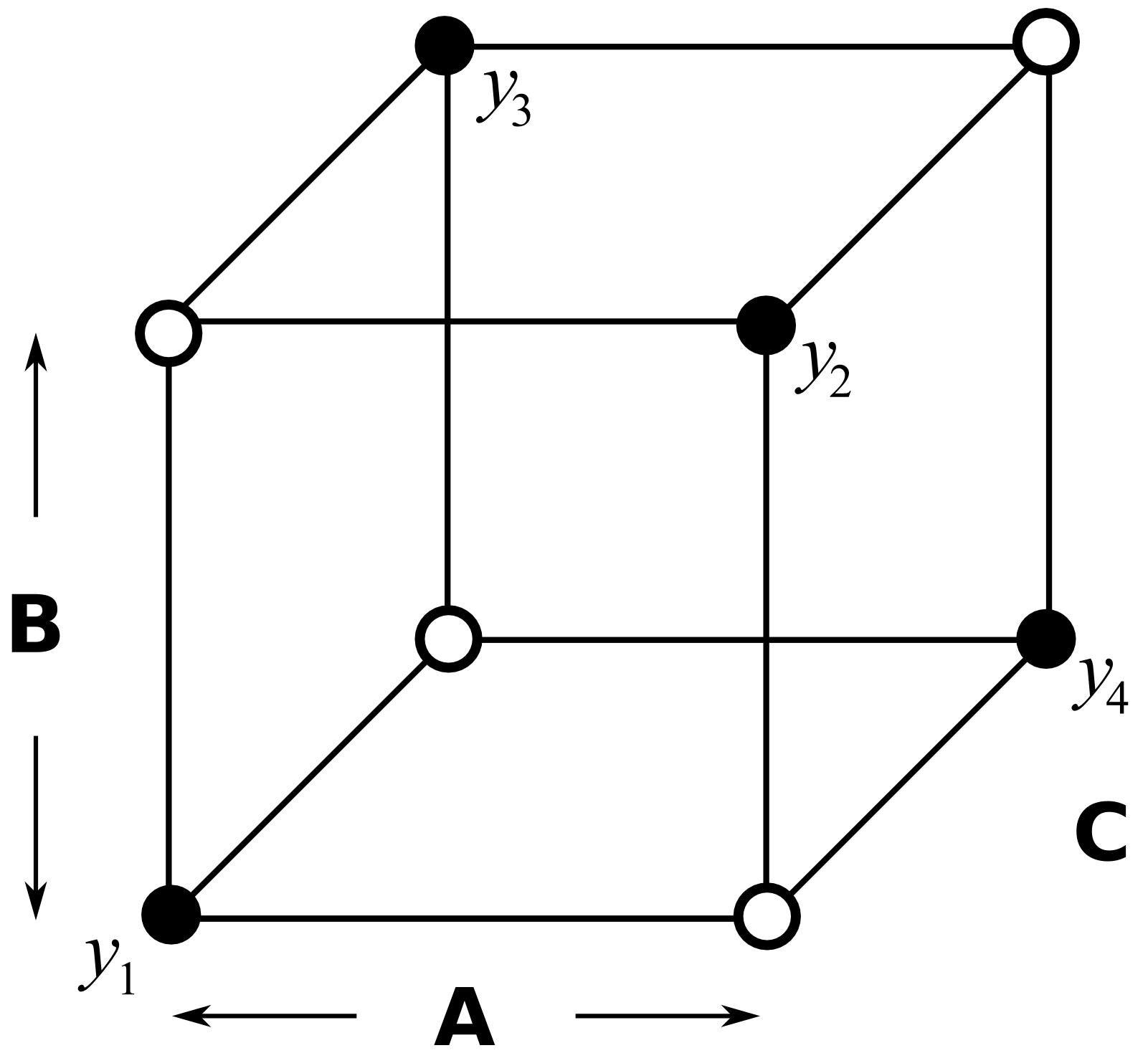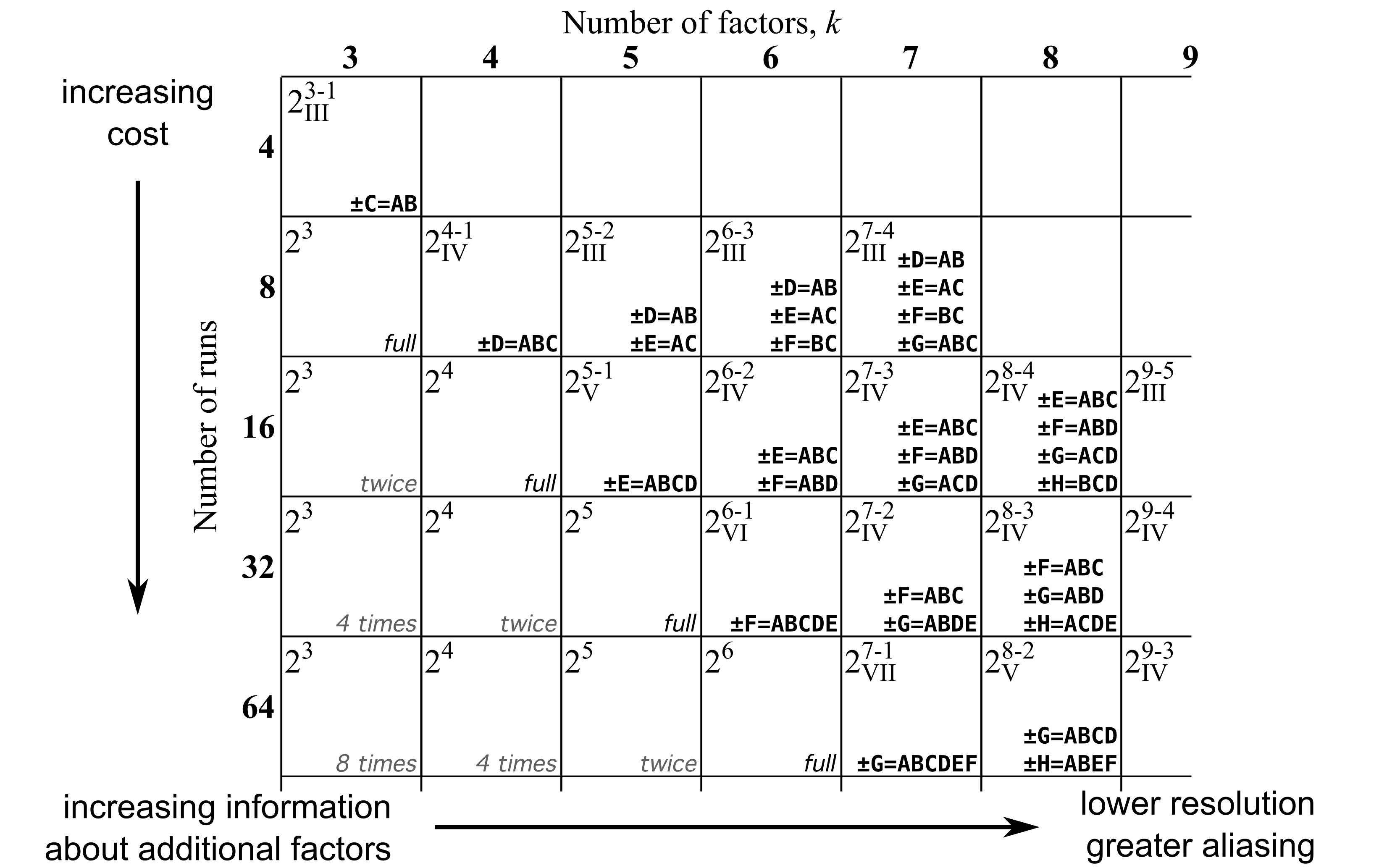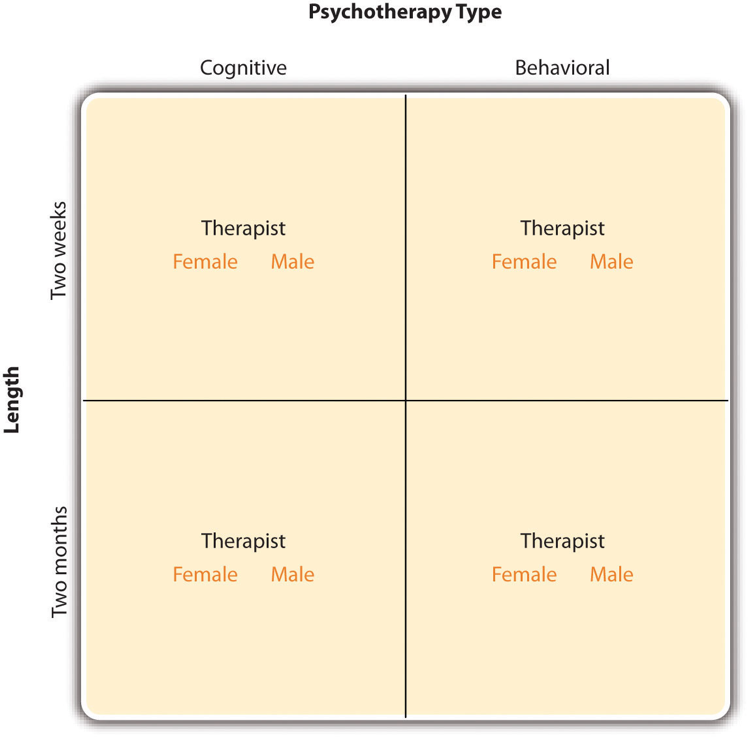Table 321 explores that possibility. Some business researchers use the factorial design as a way to control confounding or concomitant variables in a study. Advantages of full factorial design.
Advantages Of Full Factorial Design, By using a factorial design the business researcher can analyze both variables at the same time in one design saving the time and effort of doing two different analyses and minimizing the experiment-wise error rate. The factorial design as well as simplifying the process and making research cheaper allows many levels of analysis. First factorial designs provide an additional control procedure â making a secondary.
 Ppt Fractional Factorial Design Powerpoint Presentation Free Download Id 5552976 From slideserve.com
Ppt Fractional Factorial Design Powerpoint Presentation Free Download Id 5552976 From slideserve.com
An interaction is a result in which the effects of one experimental manipulation depends upon the experimental manipulation of another independent variable. Second thing if you have only 2 factors the 2 levels full factorial design has only 4 runs. A completely randomized design that you proposed runs the risk of an unbalanced design and confounding factors making it difficult to determine the effect of the individual factors. Full factorial designed experiment in two factors at two levels each in four runs Time sec Temperature C 9 980 9 1020 11 980 11 1020 The average variance of the estimates of the response at the four experimental conditions is 13 higher for the OFAT than for.
Adding 3 center points is very important for 2 reasons.
One of the primary limitations is that Factorial designs confound the effects of proportion and amount. Some business researchers use the factorial design as a way to control confounding or concomitant variables in a study. They allow the test for curvature and also. By using a factorial design the business researcher can analyze both variables at the same time in one design saving the time and effort of doing two different analyses and minimizing the experiment-wise error rate. Adding 3 center points is very important for 2 reasons. Advantages of the Factorial Design Some experiments are designed so that two or more treatments independent variables are explored simultaneously.
Read another article:
 Source: slideshare.net
Source: slideshare.net
Full factorial designed experiment in two factors at two levels each in four runs Time sec Temperature C 9 980 9 1020 11 980 11 1020 The average variance of the estimates of the response at the four experimental conditions is 13 higher for the OFAT than for. By using a factorial design the business researcher can analyze both variables at the same time in one design saving the time and effort of doing two different analyses and minimizing the experiment-wise error rate. The relative efficiency of factorials continues to increase with every added factor. The Advantages and Challenges of Using Factorial Designs One of the big advantages of factorial designs is that they allow researchers to look for interactions between independent variables. General Factor Factorial Design.
 Source: itl.nist.gov
Source: itl.nist.gov
Factorial design offers two additional advantages over OFAT. As the number of factors in a 2-level factorial design increases the number of runs necessary to do a full factorial design increases quickly. Factorial designs are extremely useful to psychologists and field scientists as a preliminary study allowing them to judge whether there is a link between variables whilst reducing the possibility of experimental error and confounding variables. An interaction means that the effect of one independent variable has on a dependent variable is not the same for all levels of the other get this information by running separate one-way analyses. 5 3 3 9 Three Level Full Factorial Designs.
 Source: itl.nist.gov
Source: itl.nist.gov
Full factorial designed experiment in two factors at two levels each in four runs Time sec Temperature C 9 980 9 1020 11 980 11 1020 The average variance of the estimates of the response at the four experimental conditions is 13 higher for the OFAT than for. They allow the test for curvature and also. A completely randomized design that you proposed runs the risk of an unbalanced design and confounding factors making it difficult to determine the effect of the individual factors. Factorial designs are extremely useful to psychologists and field scientists as a preliminary study allowing them to judge whether there is a link between variables whilst reducing the possibility of experimental error and confounding variables. 5 3 3 3 2 Full Factorial Example.
 Source: learnche.org
Source: learnche.org
In this case a Plackett-Burman designs can gather the same information on eleven variables in just 12 tests. An interaction is a result in which the effects of one experimental manipulation depends upon the experimental manipulation of another independent variable. Advantages of factorial experiments. They allow the test for curvature and also. 5 8 1 Using Two Levels For Two Or More Factors Process Improvement Using Data.

By using a factorial design the business researcher can analyze both variables at the same time in one design saving the time and effort of doing two different analyses and minimizing the experiment-wise error rate. An interaction is a result in which the effects of one experimental manipulation depends upon the experimental manipulation of another independent variable. Some business researchers use the factorial design as a way to control confounding or concomitant variables in a study. Factorial design offers two additional advantages over OFAT. Schematic Representation Of A A Two Factors Full Factorial Design Download Scientific Diagram.
 Source: slideplayer.com
Source: slideplayer.com
As the number of factors in a 2-level factorial design increases the number of runs necessary to do a full factorial design increases quickly. Full factorial designed experiment in two factors at two levels each in four runs Time sec Temperature C 9 980 9 1020 11 980 11 1020 The average variance of the estimates of the response at the four experimental conditions is 13 higher for the OFAT than for. Wider inductive basis ie it covers a broader area or volume of X-space from which to draw inferences about your process. Found inside â Page 257ADVANTAGES AND DISADVANTAGES OF FACTORIAL DESIGNS Factorial designs have several advantages over less sophisticated designs. Chapter 9 Factorial Designs Factorial Design Definition Two Or More Ivs Every Level Of One Iv Combined With Every Level Of Other Iv Ivs Called Ppt Download.
 Source: study.com
Source: study.com
For example a 2-level full factorial design with 6 factors requires 64 runs. First factorial designs provide an additional control procedure â making a secondary. They allow the test for curvature and also. This exhaustive approach makes it impossible for any interactions to be missed as all factor interactions are accounted for. Factorial Design Variations Video Lesson Transcript Study Com.
 Source: sciencedirect.com
Source: sciencedirect.com
Some business researchers use the factorial design as a way to control confounding or concomitant variables in a study. A design with 9 factors requires 512 runs. Wider inductive basis ie it covers a broader area or volume of X-space from which to draw inferences about your process. Three-level factorial design A solution to creating a design matrix that permits the estimation of simple curvature as shown in Figure 314 would be to use a three-level factorial design. Full Factorial Design An Overview Sciencedirect Topics.
 Source: learnche.org
Source: learnche.org
The drawback of a fractionated design is that some interactions may be confounded with other effects. For example a 2-level full factorial design with 6 factors requires 64 runs. Factorial design offers two additional advantages over OFAT. In this case a Plackett-Burman designs can gather the same information on eleven variables in just 12 tests. 5 9 1 Half Fractions Process Improvement Using Data.
 Source: itl.nist.gov
Source: itl.nist.gov
Factorial designs are extremely useful to psychologists and field scientists as a preliminary study allowing them to judge whether there is a link between variables whilst reducing the possibility of experimental error and confounding variables. Some business researchers use the factorial design as a way to control confounding or concomitant variables in a study. Factorial designs are extremely useful to psychologists and field scientists as a preliminary study allowing them to judge whether there is a link between variables whilst reducing the possibility of experimental error and confounding variables. An interaction is a result in which the effects of one experimental manipulation depends upon the experimental manipulation of another independent variable. 5 3 3 9 Three Level Full Factorial Designs.
 Source: learnche.org
Source: learnche.org
Doing a half-fraction quarter-fraction or eighth-fraction of a full factorial design greatly reduces costs and time needed for a designed experiment. The Advantages and Challenges of Using Factorial Designs One of the big advantages of factorial designs is that they allow researchers to look for interactions between independent variables. By using a factorial design the business researcher can analyze both variables at the same time in one design saving the time and effort of doing two different analyses and minimizing the experiment-wise error rate. Factorial designs are extremely useful to psychologists and field scientists as a preliminary study allowing them to judge whether there is a link between variables whilst reducing the possibility of experimental error and confounding variables. 5 9 6 Design Resolution Process Improvement Using Data.
 Source: sciencedirect.com
Source: sciencedirect.com
By using a factorial design the business researcher can analyze both variables at the same time in one design saving the time and effort of doing two different analyses and minimizing the experiment-wise error rate. Such experimental designs are. Full Factorial Design leads to experiments where at least one trial is included for all possible combinations of factors and levels. The factorial design as well as simplifying the process and making research cheaper allows many levels of analysis. Factorial Design An Overview Sciencedirect Topics.
 Source: slideserve.com
Source: slideserve.com
Found inside â Page 257ADVANTAGES AND DISADVANTAGES OF FACTORIAL DESIGNS Factorial designs have several advantages over less sophisticated designs. In this lesson discover the different approaches to experimental design such as between-groups within-groups single-factor and factorial and understand the advantages and disadvantages of. An interaction means that the effect of one independent variable has on a dependent variable is not the same for all levels of the other get this information by running separate one-way analyses. Three-level factorial design A solution to creating a design matrix that permits the estimation of simple curvature as shown in Figure 314 would be to use a three-level factorial design. Ppt Fractional Factorial Design Powerpoint Presentation Free Download Id 5552976.
 Source: sciencedirect.com
Source: sciencedirect.com
Advantages of factorial experiments. Advantages of the Factorial Design Some experiments are designed so that two or more treatments independent variables are explored simultaneously. Factorial designs allow additional factors to be examined at no additional cost. They allow the test for curvature and also. Full Factorial Design An Overview Sciencedirect Topics.
 Source: kpu.pressbooks.pub
Source: kpu.pressbooks.pub
In this lesson discover the different approaches to experimental design such as between-groups within-groups single-factor and factorial and understand the advantages and disadvantages of. In this lesson discover the different approaches to experimental design such as between-groups within-groups single-factor and factorial and understand the advantages and disadvantages of. For example a 2-level full factorial design with 6 factors requires 64 runs. Factorial designs are extremely useful to psychologists and field scientists as a preliminary study allowing them to judge whether there is a link between variables whilst reducing the possibility of experimental error and confounding variables. Setting Up A Factorial Experiment Research Methods In Psychology.







